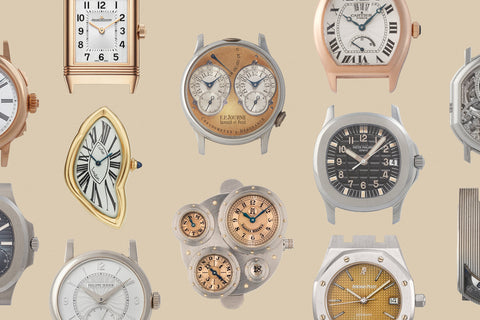The Atelier de Chronométrie is a Barcelona-based independent watchmaking collective that specialises in creating unique, bespoke watches, drawing heavily upon vintage aesthetics and cues within their work. The firm was established in 2014 by Santiago Martinez, a collector and respected vintage watch dealer who approached the watchmaker Moebius Rassmman to create their first watches.
According to Martinez, the initial desire was to create a watch that wasn't quite present on the market, "with a 'small' case and with a timeless aesthetic inspired by the past". Although some candidates for the prototype included the Peseux 260, Longines 30L, and Cyma ébauches, they eventually settled on the Omega 266. The watch took approximately 9 months to create.
This AdC1 was a prototype used to demonstrate the watch to clients. As a whole, the AdC1 takes inspiration from vintage chronometres of the 30s and 40s, as evident in the dial design and case shape. It has a two-tone sector dial, with a silvered chapter ring and a more neutral inner section. A large sub-seconds sits at 6 o’clock, with a guilloché pattern radiating outwards in concentric circles. Handmade blued steel hands in a feuille-style complete this classic dial.
The Omega 266 calibre that powers this watch is undoubtedly a highlight of this piece, and has been heavily modified. Rassmman was familiar with this ebauche, as around 2007 or 2008, he created his first watch, a weekly calendar with the Omega 266. When asked why this movement was chosen, Rassmman said: "Based on my experience in watch restoration, I observed better results and durability of its components compared to other calibers. Ultimately, we chose the Omega because it's easy to find spare parts and used movements in flea markets."
Within the prototype, certain aspects such as the wheels, anchor, balance wheel, main plate and winding mechanism are retained, while new bridges, clicks, caps, crown, posts, and some of the screws were made by hand. The finishing is entirely done by hand, with frosted movement plates, sharply bevelled edges, and black polishing on elements throughout. The case is sized at 37.5mm, and Martinez notes that back in 2016, the standard was 40mm, and although they faced some pressure to increase the size, they stuck to their decision, which has become their most popular offering for customers.
Turning the watch over reveals a sapphire caseback from which to view the movement through, and around the rim of the case is engraved “S. Martinez” and “M. Rassmman”, in addition to “Prototype” and “Chronometer”. The brushed case itself takes inspiration from vintage Patek Philippe watches, with a slim profile and tapered lugs.
This was also the first timepiece in Spanish history to be certified by the Besançon Observatory, further underscoring its geographical and historical significance. To be awarded a certificate from the Besançon Observatory, the watch had to go through a stringent testing period where the tolerances for error are very fine and the award more challenging to receive than other standards, including certified chronometers from COSC. The certificate received with this watch states the actual performance of the movement, and its status as an observatory chronometer.


























































































































































































































































































































